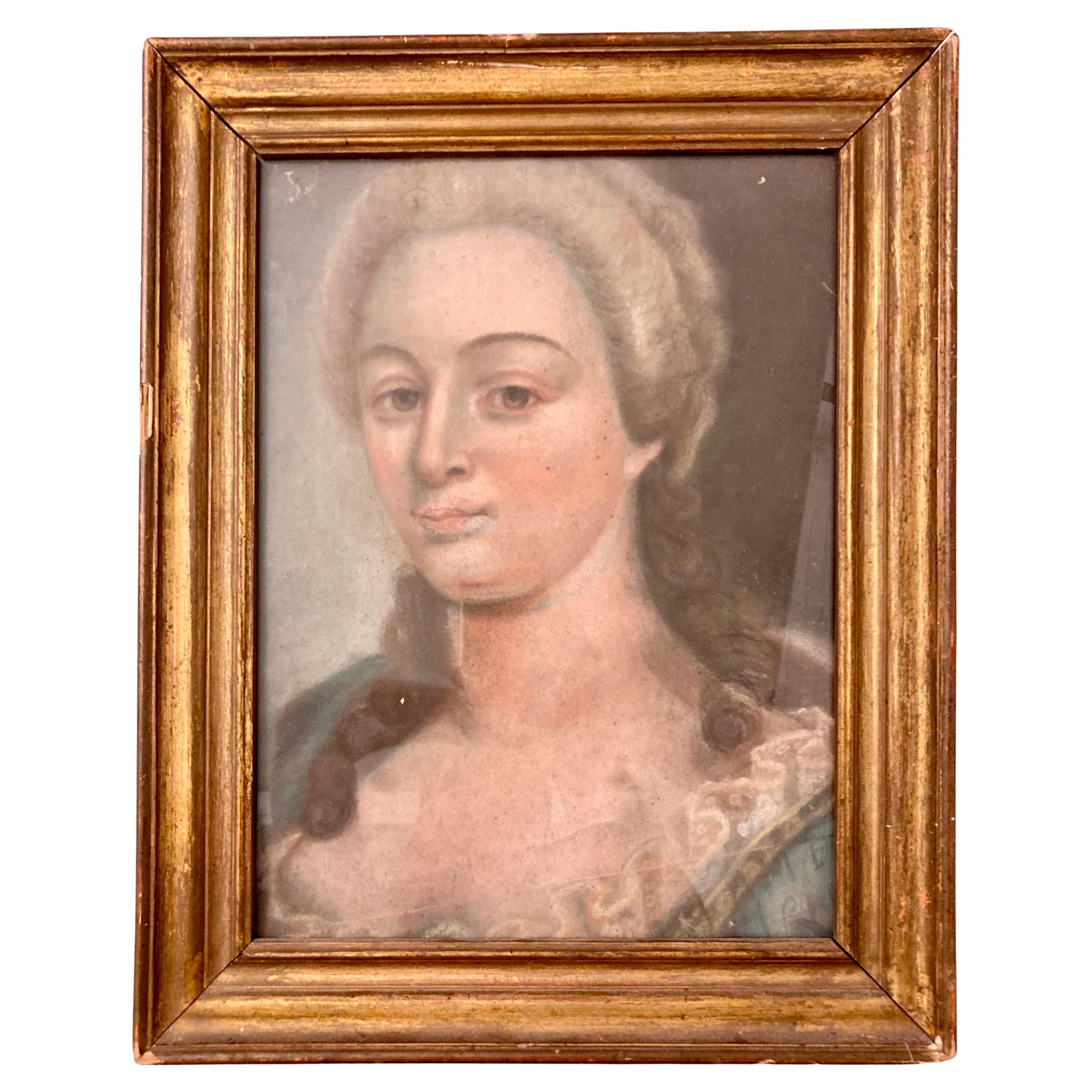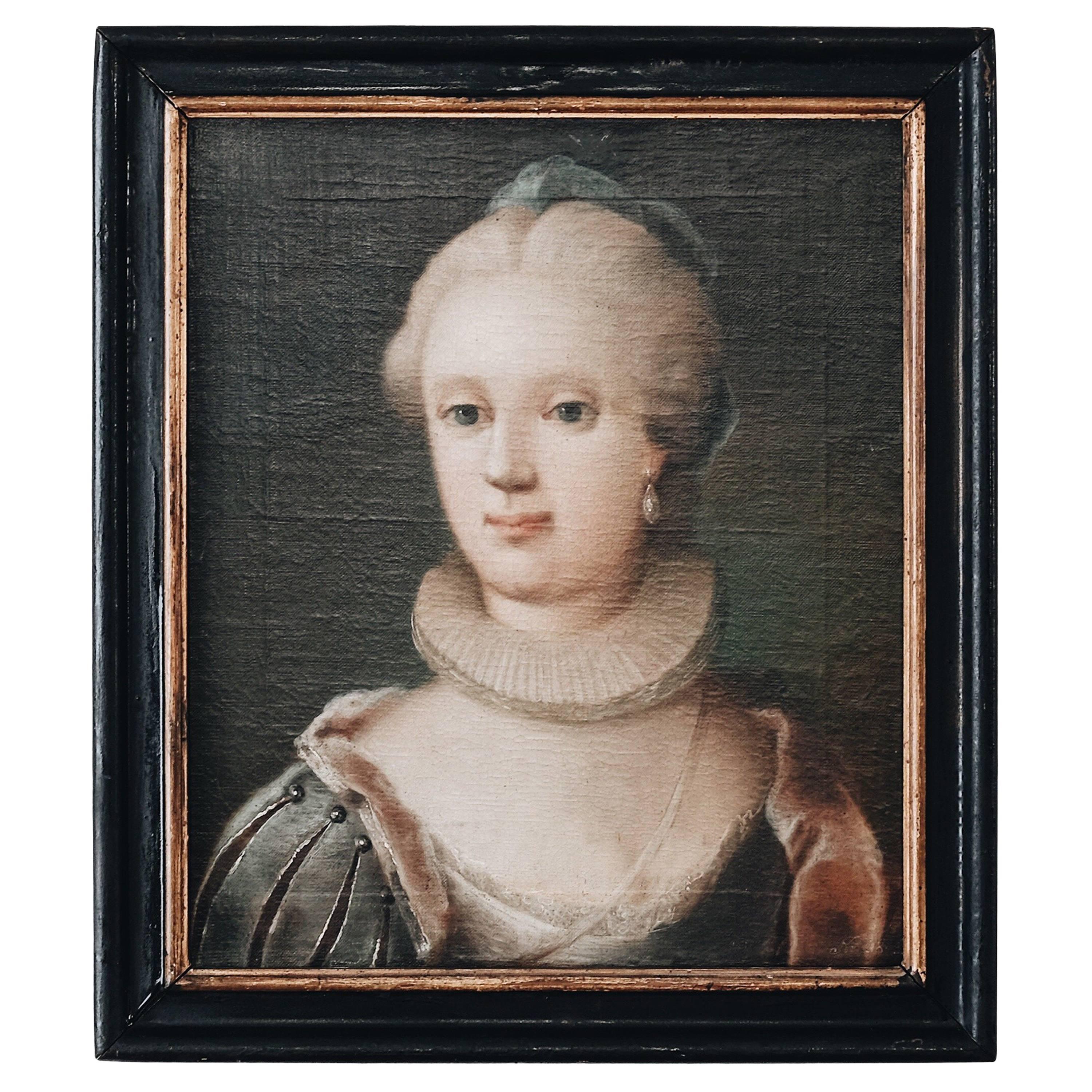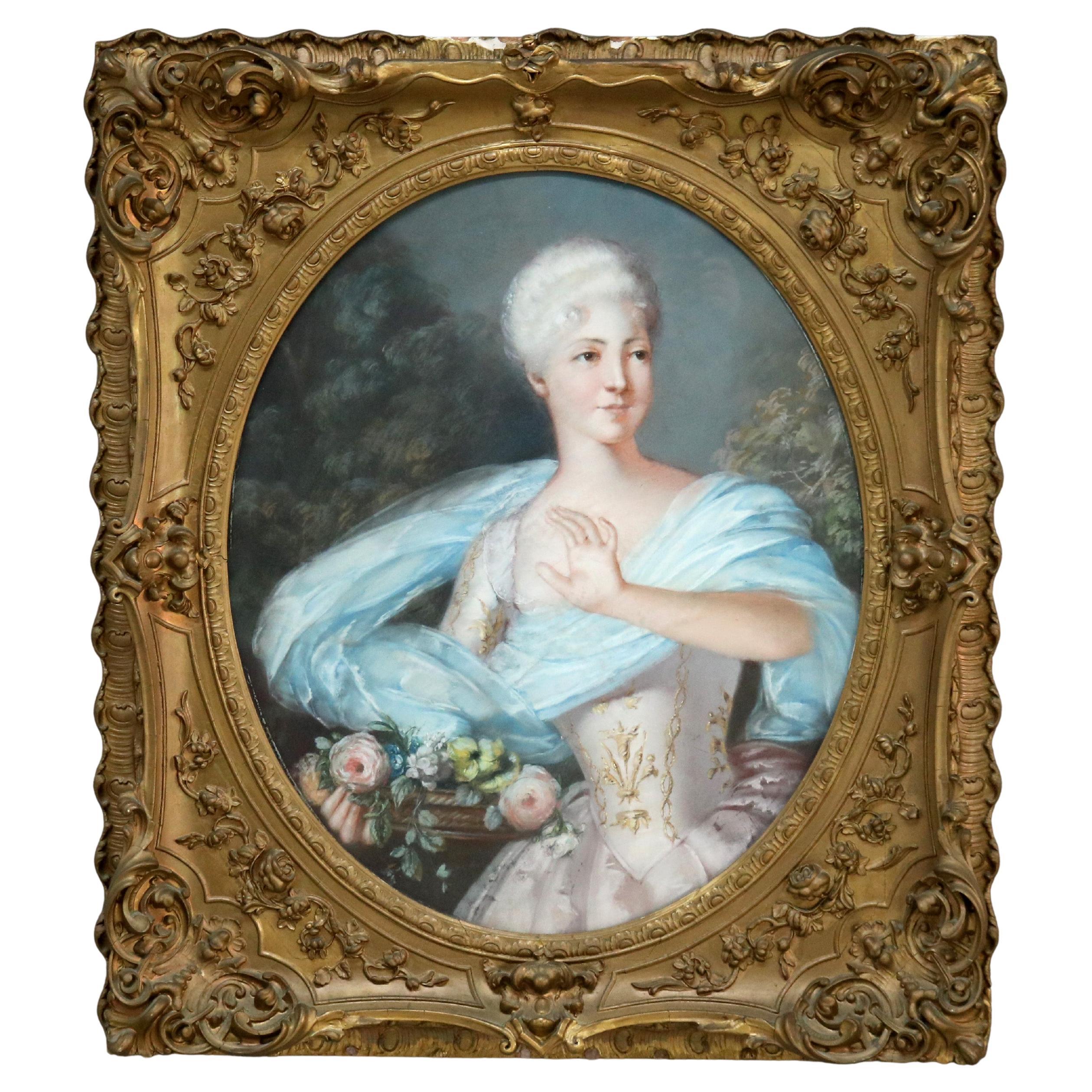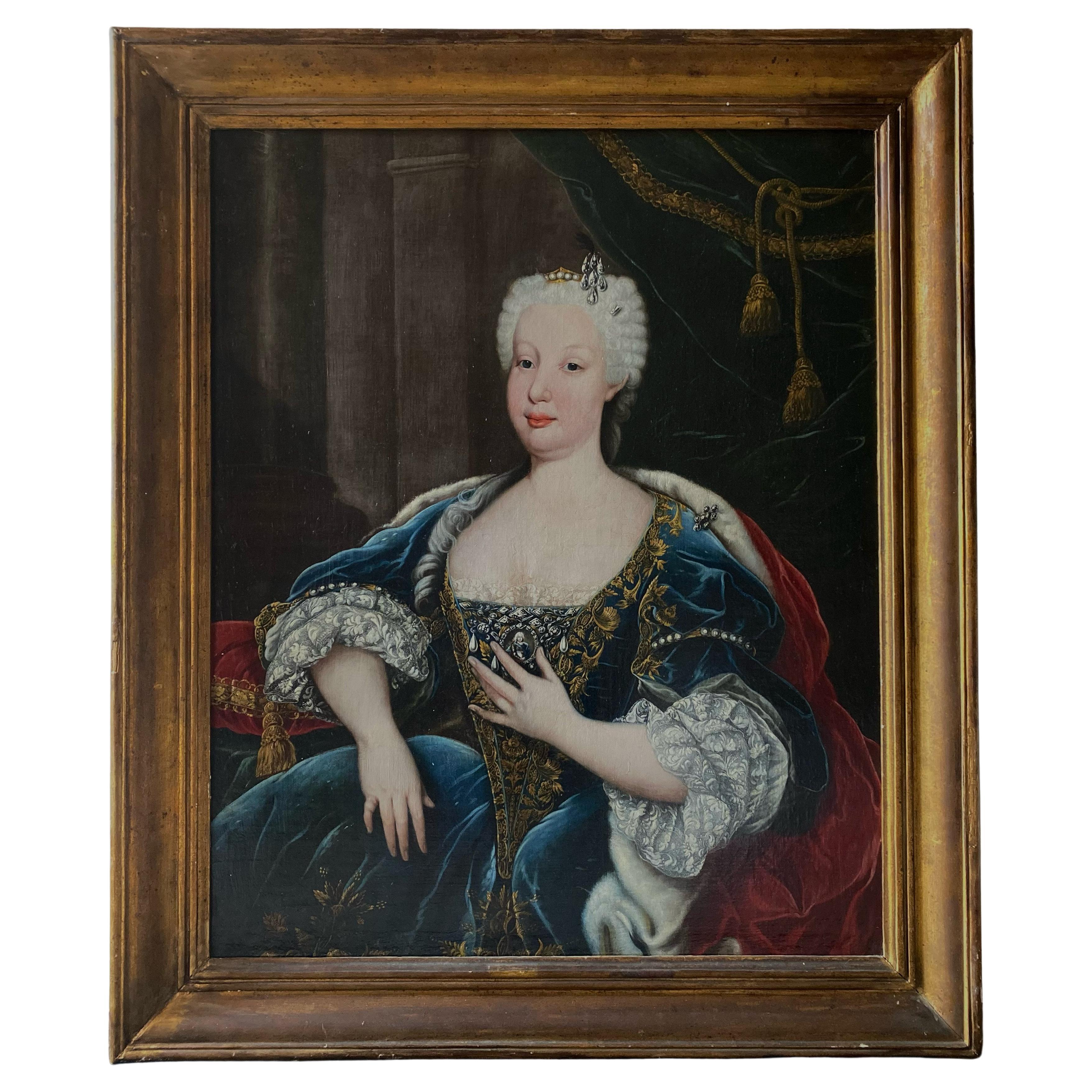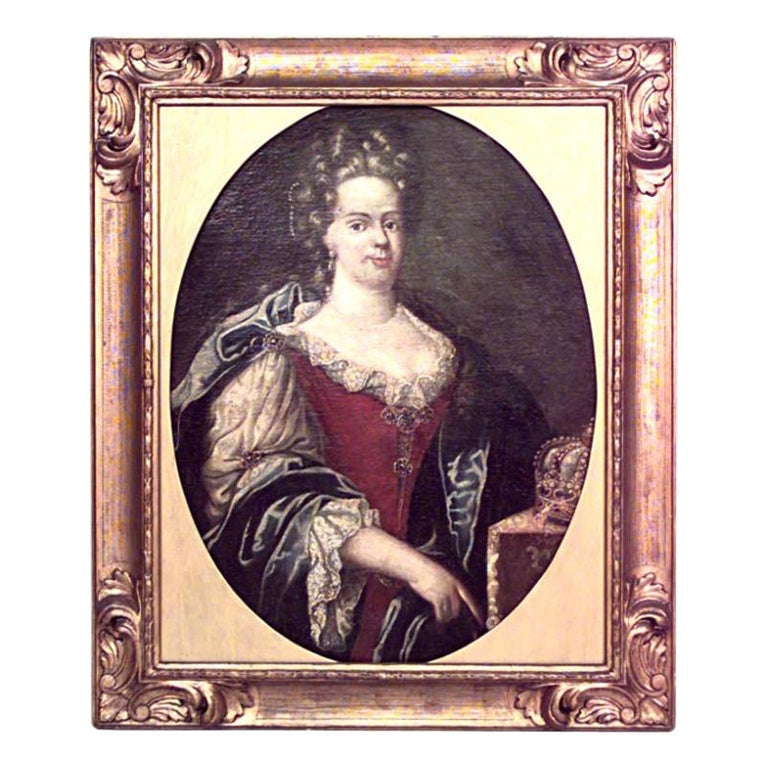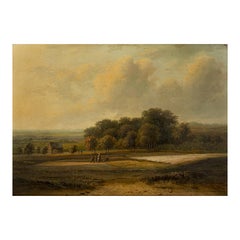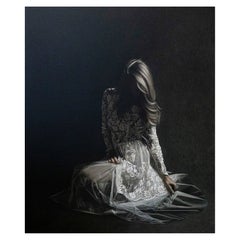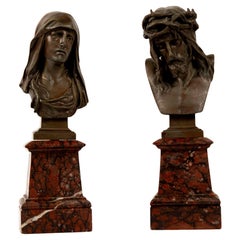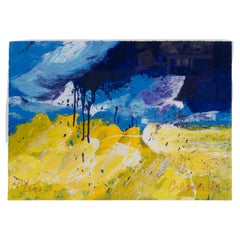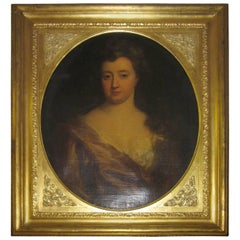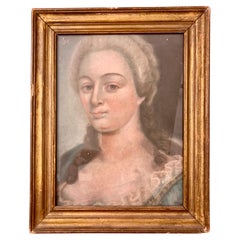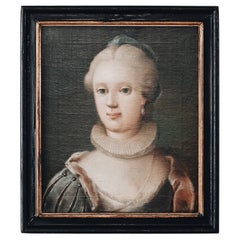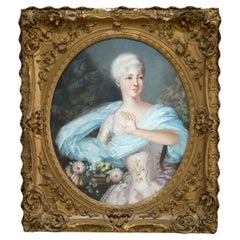Items Similar to Pastel Portret of Louise Eleonore von Hohenlohe-Langenburg
Want more images or videos?
Request additional images or videos from the seller
1 of 7
Pastel Portret of Louise Eleonore von Hohenlohe-Langenburg
$2,749.92per item
£2,035.77per item
€2,300per item
CA$3,805.20per item
A$4,195.14per item
CHF 2,194.76per item
MX$51,466.60per item
NOK 27,627.72per item
SEK 25,836.28per item
DKK 17,519.99per item
Quantity
About the Item
A finely executed pastel portrait of Louise Eleonore von Hohenlohe-Langenburg ( 1763-1837), a noblewoman whose life and status are beautifully captured in this artwork. Eleonore is portrayed intimately and gracefully, wearing a gown with fur, with her hair styled in an elegant, powdered fashion, adorned with a string of pearls which drape down to her chest. The portrait reflects the refined taste and meticulous craftsmanship of its time, possibly late 18th century, although a specific date of this artwork is not established. Perfect for collectors of historical portraiture or those seeking a statement piece with a story.
Princess Louise Eleonore of Hohenlohe-Langenburg was a significant figure in German noble history, particularly for her role as regent of Saxe-Meiningen. Born into the House of Hohenlohe-Langenburg, she came from a family with strong connections to other European noble houses. Her marriage to George I, Duke of Saxe-Meiningen, in 1782 marked the beginning of her influential role in the duchy.
When her son, Prince George II of Saxe-Meiningen, came of age, Louise Eleonore became regent for him from 1803 until 1821. This period was marked by the political and social upheavals of the early 19th century, including the Napoleonic Wars, and her leadership was instrumental in guiding the duchy through these challenges.
Louise Eleonore’s regency was notable not just for her role as a mother and protector of her son’s interests, but also for her active involvement in managing the duchy’s affairs. Her leadership during her son's minority earned her respect and allowed her to shape the political and cultural development of Saxe-Meiningen. Additionally, her background in the princely courts of both Hohenlohe-Langenburg and Saxe-Meiningen placed her in a position to navigate the complex politics of the time.
Her legacy as a regent reflects her strength and determination, as well as the importance of women in shaping European noble and political history, even in times when formal power was largely reserved for men.
- Dimensions:Height: 20.08 in (51 cm)Width: 16.54 in (42 cm)Depth: 2.37 in (6 cm)
- Style:Rococo (In the Style Of)
- Materials and Techniques:
- Place of Origin:
- Period:
- Date of Manufacture:Unknown
- Condition:Wear consistent with age and use.
- Seller Location:AMSTELVEEN, NL
- Reference Number:1stDibs: LU10205242886852
About the Seller
No Reviews Yet
Vetted Professional Seller
Every seller passes strict standards for authenticity and reliability
1stDibs seller since 2024
- ShippingRetrieving quote...Shipping from: AMSTELVEEN, Netherlands
- Return Policy
Authenticity Guarantee
In the unlikely event there’s an issue with an item’s authenticity, contact us within 1 year for a full refund. DetailsMoney-Back Guarantee
If your item is not as described, is damaged in transit, or does not arrive, contact us within 7 days for a full refund. Details24-Hour Cancellation
You have a 24-hour grace period in which to reconsider your purchase, with no questions asked.Vetted Professional Sellers
Our world-class sellers must adhere to strict standards for service and quality, maintaining the integrity of our listings.Price-Match Guarantee
If you find that a seller listed the same item for a lower price elsewhere, we’ll match it.Trusted Global Delivery
Our best-in-class carrier network provides specialized shipping options worldwide, including custom delivery.More From This Seller
View AllPastoral scene by Andreas Danekes (1833)
Located in AMSTELVEEN, NL
Oil on panel painting by Andreas Danekes (Amsterdam 1788, 1855 Hilversum)
Category
Antique 1830s Dutch Romantic Paintings
Materials
Acrylic
Meg den Hartog, Reflection (2017)
Located in AMSTELVEEN, NL
Meg den Hartog (b. December 30, 1952) is a Dutch painter based in Houten, known for her romantic-realistic style and exceptional attention to detail. Growing up in a creative family, Meg was exposed to the world of art from a young age. After studying under Poen de Wijs from 2005 to 2014, Meg mastered the "stricheltechnik" technique—a method of building up layers with fine strokes to create highly realistic imagery. While de Wijs focused on magical realism, Meg developed her own style, emphasizing the romantic realism...
Category
2010s Dutch Modern Paintings
Materials
Acrylic
$8,847 Sale Price / item
20% Off
Eugène Marioton (1854-1933) Busts of Christ and Mary
By Eugene Marioton
Located in AMSTELVEEN, NL
Bronze Busts of Christ and Mary with Red Marble Bases
Eugène Marioton (Paris 1854–1933)
This exceptional pair of bronze busts, one depicting Jesus Christ with a crown of thorns and ...
Category
Early 20th Century French Busts
Materials
Marble, Bronze
'Provence II', Jan Cremer (1989)
By Jan Cremer
Located in AMSTELVEEN, NL
This vibrant, large screenprint, "Provence II," is a quintessential work by the iconic Dutch enfant terrible, Jan Cremer (1940-2024). Created in 1989, this powerful piece is hand-sig...
Category
Vintage 1980s Dutch Other Contemporary Art
Materials
Paper
Sleeping Baby, Jan Sluijters (1881-1957)
By Jan Sluijters
Located in AMSTELVEEN, NL
This oil painting on panel by Jan Sluijters depicts a peaceful domestic scene of a sleeping child surrounded by scattered toys on a soft blanket. The work radiates tenderness, with Sluijters’ characteristic use of light and color lending warmth and intimacy to the composition. The baby’s serene expression highlight Sluijters’ mastery of capturing everyday life with emotional depth.
Jan Sluijters (1881–1957) was a pioneering Dutch painter who significantly modernized Dutch art in the early 20th century. His style evolved from luminism to fauvism, expressionism, and eventually realism, with his works often celebrating modern life and domestic intimacy. Known for his vibrant use of color and light, Sluijters produced a wide range of works, including portraits, landscapes, and scenes of everyday life. His contributions to modern Dutch art...
Category
Antique Early 19th Century Expressionist Paintings
Materials
Acrylic
Heidi von Faber, Strawberries, 2007
Located in AMSTELVEEN, NL
Heidi von Faber is a Dutch realist painter based in The Hague, inspired by the old Dutch Masters and their masterful manipulation of light and shadow. Her work is characterised by hy...
Category
Early 2000s Dutch Modern Paintings
Materials
Acrylic
You May Also Like
18th century Portrait of Lady Oil on Canvas in Giltwood Frame
Located in Savannah, GA
English oil on canvas portrait dating from the late 1700s painted in the manor of Joshua Reynolds. We believe the giltwood frame could be the original as it is right for the period. ...
Category
Antique 1790s English Rococo Paintings
Materials
Canvas, Wood
$3,900 Sale Price
40% Off
French 18th Century Pastel Drawing Portrait of a Lady
Located in Los Angeles, CA
French 18th Century pastel portrait drawing of a lady. Beautiful details and gorgeous old gilt frame. Glass is old with bubbles. Add some classic French style to your home.
Category
Antique Early 18th Century French Provincial Paintings
Materials
Canvas
18th Century Portrait
Located in Allerum, SE
Fine 18th century portrait of a lady, unsigned, circa 1750, Sweden.
(reframed, oil on canvas) According to old frame painted by Johan Horner (...
Category
Antique 18th Century Swedish Rococo Paintings
Materials
Canvas
$4,320 Sale Price
20% Off
Antique Louis XIV Pastel Portrait of a Noble Woman C1870
Located in Big Flats, NY
***Reduced In-House Delivery Rates - Click on “Ask Seller” to Request a Quote***
Antique Louis XIV Giltwood Portrait of A Noble Woman with Gilt Fr...
Category
Antique Mid-19th Century Paintings
Materials
Giltwood
Portrait of D. Maria Bárbara De Bragança, Circle of Louis-Michel Van Loo
By H. van Loon
Located in Lisboa, PT
PORTRAIT OF D. MARIA BÁRBARA DE BRAGANÇA (1711-1758), QUEEN OF SPAIN
Circle of Louis-Michel van Loo (1707-1771)
Oil on canvas
Her Royal Highness, the Infanta Maria Barbara of Braganza (1711-1758) was the first-born child of King John V of Portugal (1689-1750) and his queen consort Maria Anna of Austria (1683-1754). Born in December 1711, she had the Convent Palace of Mafra built in her honour following a vow made by her royal father. Her status as Princess of Brazil, inherent to 18th century Portuguese presumptive heirs, would however be superseded once the queen gave birth to two male princes, D. Pedro (1712-1714) and D. José (1714-1777), preventing her from ascending to the throne.
Daughter of one of the most illustrious monarchs of his time, Maria Barbara was carefully educated to become a fond admirer of the arts, and of music in particular, having had the Italian composer Domenico Scarlatti (1685-1757) as her music teacher.
On the 10th January 1723 the young princess was betrothed to the Infante Ferdinand of Spain (1713-1759), eldest son of King Philip V (1683-1746). Six years later, on the 19th January, she entered her new country in a carefully choreographed ceremony that became known to history as the “Exchange of the Princesses”. This unique event took place on a specially built Bridge-Palace, a wooden, luxuriously decorated structure that included various modules and rooms, on both banks of the river Caia, the natural border between the town of Elvas in Portugal and of Badajoz in Spain. Simultaneously, on the same day that the Portuguese Infanta crossed the border to marry the Spanish Crown Prince, her new sister in law, the Infanta Mariana Victoria of Bourbon (1718-1781), her husband’s sister, crossed the same bridge in the opposite direction to marry Prince D. José, the Portuguese heir to the throne.
Once married, Maria Barbara would spend 17 years as Princess of Asturias, only becoming Queen of Spain at her husband’s accession following the death of Philip V in 1746. She is portrayed in the 1743 painting by Louis-Michel van Loo (1707-1771) now in the Prado Museum, in which Philip V had himself represented with all his close family.
The new Queen would take an important role at court eventually becoming the liaison between her husband and the King of Portugal, particularly throughout the negotiations for the Treaty of Madrid (1746-1750). Maintaining her interest in music, she patronized the Italian castrato singer Farinelli (1705-1782) while remaining close to her old master Scarlatti, having herself composed some sonatas for a large orchestra. She would also commission and fund the building of the Royal Salesians Monastery complex in central Madrid, where both her and Ferdinand VI are buried.
The portrait we are presenting for sale shows the Queen in half-length, turning left at three quarters. She is wearing a blue low-cut dress embroidered with flowers and foliage, over a lace cuffed white blouse, and an ermine cloak pined on the left-hand side by a diamond broach. The powdered hair style is held sideways by a seven diamond and black plume headdress and topped by a small gold and pearl crown. The right arm rests on a cushion while the left hand, at chest height, holds a miniature male portrait.
The Infanta’s features are analogous to the 1725 portrait by the painter Domenico Duprà (1689-1770), also in the Prado Museum collection. Further similarities can be found in another portrait by Louis-Michel van Loo, in which a seven diamond and black plume headdress is also present. In this work, the cushion supporting Maria Barbara’s right arm has also some obvious similarities to our painting. The same diamond headdress reappears in Van Loo’s above-mentioned portrait of Philip V’s family dated from 1743.
It is nevertheless in Lisbon’s Ajuda National Palace that it is possible to find an almost identical depiction of the Infanta holding a miniature portrait of her husband. In it, the future Ferdinand VI is portrayed facing right at three quarters and wearing a curly wig, suit of armour, the golden fleece insignia and a blue band, in a composition that closely resembles an 18th century Spanish school painting that appeared in the art market in January 2016.
Another detail common to various portraits of the Portuguese Infanta and Queen of Spain is the small gold and pearl crown on her head. In another Van Loo painting, also from the Prado Museum, in which Maria Barbara is portrayed as Queen, this crown is represented together with a headdress similar to the one previously described. Another two paintings by the same artist, at the Royal Academy of Saint Ferdinand, include the same ornament.
We must also refer the paintings by the artist Jean Ranc (1674-1735). In one, dating from 1729 (Prado Museum), the Infanta is depicted outdoors holding a flower bouquet and wearing a yellow silk dress with red cloak, and a set of diamond and ruby jewellery that includes a headdress similar to the one present in our portrait. Another work by the same artist, belonging to the Complutence University of Madrid, depicts the Infanta sumptuously dressed in identical colours to our painting and wearing an elaborate headdress and diadem.
These portraits, beyond their iconographical importance as contemporary records of the Infanta and Queen Maria Barbara, are also illustrative of 18th century fashion for jewelled head dressing. Often, flowers were combined with joyful adornments, composing almost theatrical displays that would reinforce the ostentatious nature of the image. The ornamental flowers and the chromatic character of the jewels would complement the luxury of the colourful dresses in blue, crimson, green or other silk shades, in compositions whose sole purpose was to highlight a royal sitter’s wealth and power, becoming an essential statement accessory within the strict court protocols and codes of conduct.
Circle of Louis-Michel van Loo (1707-1771)
Slowly but steadily, the resolute, tranquil and dignified attitude of Renaissance and Baroque portraiture becomes artificial and presumptuous. Mid 18th century society favours elusive expression and psychological deepness, albeit limited to the face, that, with emphasis on detail, on the rich colour palette and on changing costumes and landscapes, associated to the courtliness of gestures, creates a strongly artificial environment while maintaining a highly poetic intrinsic character.
Louis-Michel van Loo followed a dynasty of famous Dutch origin artists that had settled in France. Initially taught by his father, Jean-Baptiste von Loo (1684-1745), the younger van Loo studied in Turin and Rome and frequented the Paris Academy. In Rome he worked with his uncle Charles-André van Loo (1705-1765) and become a painter for the Turin Court. In 1737 he arrived in Spain being summoned by Philip V to succeed Jean Ranc as painter of the king’s chamber.
In Madrid, his work covers the numerous Court commissions and the Royal Saint Ferdinand Fine Arts Academy, of which he was a founding member and director for the Painting department in 1752. Is production at court consisted essentially of numerous portrait paintings, often Royal gifts...
Category
Antique 18th Century Spanish Baroque Paintings
Materials
Canvas
French Louis XVI Crowned Lady Portrait
Located in Queens, NY
French Louis XVI style (18th Cent) gilt framed oval oil painting portrait of lady wearing crown
Category
Antique 18th Century French Louis XVI Paintings
Materials
Paint
More Ways To Browse
Native American Ledger
Antique Wood Tool Boxes
Antique Wooden Bottle
Antique Wooden Boxes With Lids
Antique Woodworking Tools
Antique Yixing
Antique Zeppelin
Arched Double Doors
Art Deco Glass Trinket Box
Art Deco Maple Dresser
Art Deco Springer Chair
Art Nouveau Iron Chair
Art Studio Storage
Ashford Black Marble
Asian Door Panel
Baccarat Casket
Baker Headboard
Baker New World

